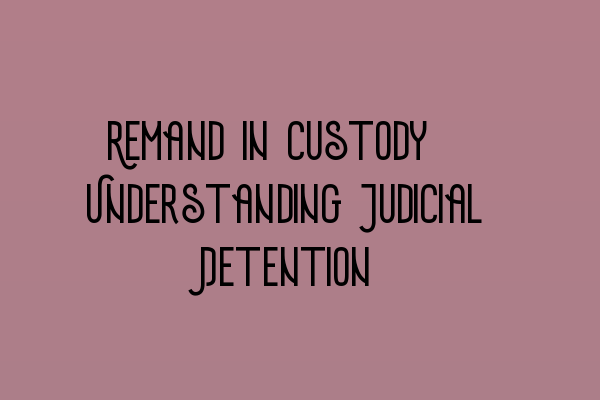Remand in Custody: Understanding Judicial Detention
When it comes to criminal law cases, one aspect that often comes into consideration is remand in custody. Understanding the concept of judicial detention is crucial for both legal practitioners and those seeking legal representation. In this article, we will shed light on what remand in custody entails and its significance in criminal proceedings.
What is Remand in Custody?
Remand in custody refers to the situation where an individual charged with a criminal offense is detained in custody until their trial or the case is resolved. This decision is made at a judicial hearing, where the court determines whether it is necessary to keep the accused in custody or release them on bail.
Understanding the factors that contribute to remand in custody is essential for legal professionals. It involves assessing the likelihood of the accused absconding, interfering with witnesses, committing further offenses, or endangering public safety. The court evaluates these risks to determine whether it is necessary to detain the accused until their trial.
The Significance of Judicial Detention
Judicial detention serves various purposes within the criminal justice system. Firstly, it ensures that individuals charged with serious criminal offenses do not evade justice by absconding before their trial. This is particularly crucial when the evidence against the accused is strong, and there is a high risk of them attempting to avoid prosecution.
Furthermore, judicial detention helps to safeguard witnesses and the community at large. By keeping the accused in custody, the risk of interference with witnesses or potential harm to the public is minimized. This is especially important in cases where the accused has a history of violent behavior or where the alleged offense is particularly severe.
It is important to note that judicial detention should always be utilized as a measure of last resort. The principles of fairness and proportionality must guide the decision-making process, ensuring that the accused’s rights are upheld while protecting the interests of justice.
Challenges Faced in Remand in Custody Cases
As with any legal process, remand in custody is not without its challenges. One major concern is the potential for wrongful detention. In some cases, individuals may be held in custody for an extended period, only to be acquitted or have their charges dropped. Such situations call for a careful evaluation of the evidence and a thorough assessment of the necessity for continued detention.
Another challenge arises in cases where conditions in detention centers are substandard. It is crucial for legal practitioners and authorities to ensure that individuals in custody are held in appropriate facilities that meet the necessary standards to safeguard their well-being.
Conclusion
Remand in custody plays a vital role in the criminal justice system, ensuring the proper administration of justice and protecting the rights of all involved parties. By understanding the concept of judicial detention and the factors that contribute to it, legal professionals can effectively advocate for their clients and uphold the principles of fairness and proportionality.
If you’re preparing for the SQE exams, make sure to check out the following related articles:
- SQE 1 Practice Exam Questions
- SQE 1 Practice Mocks FLK1 FLK2
- SQE 2 Preparation Courses
- SQE 1 Preparation Courses
- SRA SQE Exam Dates
